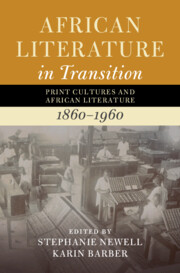Book contents
- African Literature in Transition
- African Literature in Transition
- African Literature in Transition
- Copyright page
- Contents
- Figures
- Tables
- Contributors
- Introduction
- Part I Producing Print
- Part II Readers and Audiences
- Chapter 7 Black South African Intellectuals and the Question of Colonial Modernity
- Chapter 8 ‘How to cultivate a love for reading’
- Chapter 9 Print Culture and New Fictional Imagination in Colonial Egypt
- Chapter 10 A Century of Readers and Readings
- Part III New Genres
- Part IV Worlds of Print
- Index
- References
Chapter 10 - A Century of Readers and Readings
Abantu Abamnyama, 1922–2022
from Part II - Readers and Audiences
Published online by Cambridge University Press: 23 October 2025
- African Literature in Transition
- African Literature in Transition
- African Literature in Transition
- Copyright page
- Contents
- Figures
- Tables
- Contributors
- Introduction
- Part I Producing Print
- Part II Readers and Audiences
- Chapter 7 Black South African Intellectuals and the Question of Colonial Modernity
- Chapter 8 ‘How to cultivate a love for reading’
- Chapter 9 Print Culture and New Fictional Imagination in Colonial Egypt
- Chapter 10 A Century of Readers and Readings
- Part III New Genres
- Part IV Worlds of Print
- Index
- References
Summary
When Magema M. Fuze published his seminal book Abantu Abamnyama Lapa Bavela Ngakona in 1922, he could not have anticipated that one hundred years later, he would be an iconic writer; a representative of nineteenth-century black letters; a Kholwa intellectual and a remnant of the bygone era of mission stations and mission schools. This chapter will re-visit Magema Fuze’s readers and readings in light of this centenary and re-evaluate the extent to which his contribution to the study of African print cultures has enriched our understanding of the role played by the arrival of the printing press in Southern Africa. His pioneering work of history, ethnography and oral lore will be re-examined from the perspective of his journalistic texts and newspaper columns. The objective will be to show how a century of readers and readings have accrued to create a legacy; and, how such a legacy continues to challenge and be challenged by ever more increasing archiving practices and textual analysis.
Keywords
Information
- Type
- Chapter
- Information
- African Literature in TransitionPrint Cultures and African Literature, 1860–1960, pp. 202 - 218Publisher: Cambridge University PressPrint publication year: 2025
References
Accessibility standard: Inaccessible, or known limited accessibility
Why this information is here
This section outlines the accessibility features of this content - including support for screen readers, full keyboard navigation and high-contrast display options. This may not be relevant for you.Accessibility Information
Content Navigation
Allows you to navigate directly to chapters, sections, or non‐text items through a linked table of contents, reducing the need for extensive scrolling.
Provides an interactive index, letting you go straight to where a term or subject appears in the text without manual searching.
Reading Order & Textual Equivalents
You will encounter all content (including footnotes, captions, etc.) in a clear, sequential flow, making it easier to follow with assistive tools like screen readers.
You get concise descriptions (for images, charts, or media clips), ensuring you do not miss crucial information when visual or audio elements are not accessible.
You get more than just short alt text: you have comprehensive text equivalents, transcripts, captions, or audio descriptions for substantial non‐text content, which is especially helpful for complex visuals or multimedia.
Visual Accessibility
You will still understand key ideas or prompts without relying solely on colour, which is especially helpful if you have colour vision deficiencies.
You benefit from high‐contrast text, which improves legibility if you have low vision or if you are reading in less‐than‐ideal lighting conditions.
